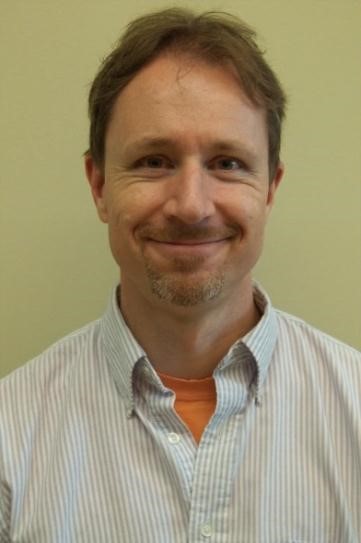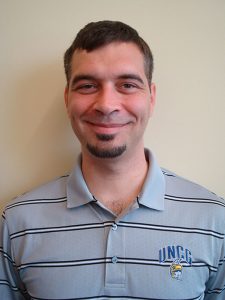
Department Head, Associate Professor
prpratap@uncg.edu
Petty 322
Website
MS: Indian Institute of Technology, Bombay; PhD: Syracuse University
Over the past 30 years, Dr. Pratap’s research has focused on the energetics of membrane ion transporters – specifically, the sodium and potassium pump. This membrane protein converts chemical energy into electrochemical potential energy stored in transmembrane gradients of sodium and potassium. In a human at rest, this pump uses approximately 25% of the body’s total energy budget. The pump is also the target of digitalis, a drug administered to increase the strength of heart muscle contractions. Pratap uses various spectroscopic techniques (ensemble fluorescence and FTIR spectroscopy, and single-molecule fluorescence fluctuations) to examine various steps in the pump’s reaction cycle with the overall goal of determining the pump’s energy conversion efficiency.

Assistant Professor
anaarnio@uncg.edu
Petty 332
Website
BA: Smith College; PhD: Vanderbilt University
Prof. Aarnio is interested in solar and stellar magnetic fields. She studies how magnetic fields facilitate the flux of mass and energy within a star-disk system and how they drive solar and stellar activity, outflows, and accretion. Aarnio uses large data sets and the solar-stellar connection to understand stars like the Sun when it was a few million years old and how it evolved to be the star we know now. Her results from stellar observations and models inform possible solar extremes that are of great concern for the denizens of 1 au. Prof. Aarnio observes, taking photometric and spectroscopic data, and models, running radiative transfer and magnetohydrodynamic convection codes to understand the data she gathers.

Associate Professor and Director of Undergraduate Studies
idbeatty@uncg.edu
Petty 328
Website
BS & PhD: University of Massachusetts
Dr. Beatty’s main interest is in Physics Education Research. This research ranges from cognitive modeling (“How do we gauge and represent the physics knowledge in a student’s or expert’s head?”) through statistical methods (“How do we extract reliable measures of students’ affective traits from questionnaire data?”) to the engineering and evaluation of curricula and learning environments (“How do we engage students more deeply and authentically in physics learning, taking hints from how good video games engage players in exploring confusing environments and mastering hard skills?”). He also wants to integrate computational methods and simulation more deeply into the physics curriculum.
 Dr. Ron Belmont
Dr. Ron BelmontAssistant Professor
rjbelmon@uncg.edu
Petty 331
Website
BS: Seton Hall University; MS & PhD: Vanderbilt University
Ron Belmont is an internationally recognized expert in the physics of ultrarelativistic nucleus-nucleus collisions. By colliding heavy nuclei at relativistic speeds, we create a new phase of matter called the quark-gluon plasma, which is believed to have existed in the very early universe, roughly a few microseconds after the big bang. Ron is a member of the PHENIX Collaboration, where he is a physics working group convener and a member of the executive council and institutional board. Ron is also a member of the sPHENIX Collaboration, where he is an institutional board member and one of the experts on the hadronic calorimeter subsystem.

Lecturer
adcovell@uncg.edu
Petty 333
BA: University of North Carolina Greensboro; PhD: Joint School of Nanoscience & Nanoengineering
Dr. Covell is interested in solid state battery separators for multivalent ion battery applications and is currently using first principle calculations to investigate ionic conductivity in proposed solid state materials. He is also interested in curriculum development and gamification, where he is developing/adapting course materials for online platforms and delivery.

Professor
ehhellen@uncg.edu
Petty 318
BS: University of Wisconsin; PhD: University of Michigan
Dr. Hellen is interested in Nonlinear Dynamics and emergent behavior, most recently using numerical and electrical models to study collective modes and multi-stability in coupled synthetic genetic ring oscillators. For numerical simulations he formerly used Fortran, then MathCad, then Matlab, but now mostly uses Python and XPPAUT on both Windows and Linux, and AUTO-07p on Linux.

Professor and Director of Three College Observatory
a_mirosh@uncg.edu
Petty 335
Website
MS: Saint-Petersburg State University; PhD: Pulkovo Astronomical Observatory of the Russian Academy of Sciences; Second PhD: Special Astrophysical Observatory of the Russian Academy of Sciences
Dr. Miroshnichenko’s research interests include studies of hot stars with large amounts of circumstellar material, such as Be stars, objects with the B[e] phenomenon, young stars, binary systems, spectroscopy and photometry (methods of observation) , and radiation transfer (method of computational analysis).